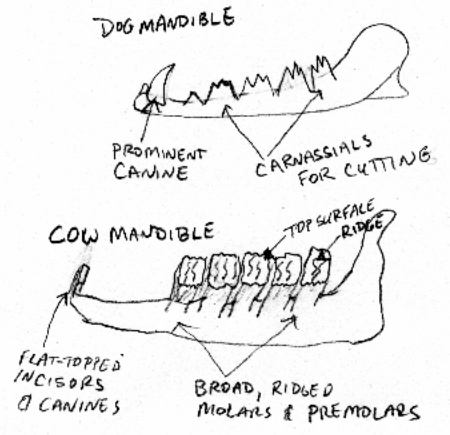
COMMUNICATION
IN THE BIOLOGICAL SCIENCES
Department
of Biology
ANSWERING LONG ESSAY QUESTIONS CORRECTLY

COMMUNICATION
IN THE BIOLOGICAL SCIENCES
Department
of Biology
ANSWERING LONG ESSAY QUESTIONS CORRECTLY
A Sample Long Essay Question:
Compare and contrast a carnivorous mammal and an herbivorous mammal focusing on how their teeth and digestive tract are specialized for their lifestyle. Use specific examples from class to support your answer. Provide at least one diagram depicting specializations in the anatomies of a carnivore and herbivore.
A Good Answer (Click here for an explanation of why it is a good answer):
The overall mammalian body plan imposes certain similarities on the digestive systems of most mammals regardless of their type of diet. For example, in both a carnivore, like a dog, and an herbivore, like a cow, the actual breakdown and digestion of food takes place primarily in the mouth, stomach, and small intestine. Digestive enzymes are supplied by the salivary glands and pancreas in both mammals. Absorption of nutrients occurs in the small and large intestine in both animals. Both dogs and cows have a bony skull with teeth embedded in the premaxilla, maxilla, and mandible.
Even with these evolutionarily-imposed similarities, the digestive tract of a carnivore differs significantly from an herbivore. The dog takes in highly nutritious food which digests quickly. Therefore, the stomach of the dog is relatively small, and the intestines are not overly long for the animal's size. In contrast, the cow's diet consists of food rich in cellulose that requires a long time to digest. Therefore, the cow has a large four-chambered stomach in order to handle the greater mass of food which is required. In addition, the cow's stomach has a rich bacterial and protistan culture that is required to break down the cellulose. Dogs do not have this requirement.
The teeth of a cow and a dog are also specialized for their diets. The dog has large, dagger-like canines for catching and killing prey. The cheek teeth of a dog consist of sharp carnassials which are specialized for cutting out chunks of meat. Typically, they do not chew their food and have no teeth specialized for chewing. In contrast, the cow's incisors are specialized for nipping off grasses, and their molars are broad and ridged for extensive grinding and chewing of their cud. See the diagram below.

What Makes This a Good Answer:
Click here
to see how to plan to answer this question.
Copyright © 2001, the University of Wisconsin-La Crosse and the Board of Regents of the University of Wisconsin.